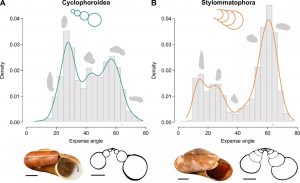Many roads to success: alternative routes to building an economic shell in land snails
Barna Páll-Gergely, András Á. Sipos, Mathias Harzhauser, Aydın Örstan, Viola Winkler, Thomas A. Neubauer.
Abstract: Land snails exhibit an extraordinary variety of shell shapes. The way shells are constructed underlies biological and mechanical constraints that vary across gastropod clades. Here, we quantify shell geometry of the two largest groups, Stylommatophora and Cyclophoroidea, to assess the potential causes for variation in shell shape and its relative frequency. Based on micro-computed tomography scans, we estimate material efficiency through 2D and 3D generalizations of the isoperimetric ratio, quantifying the ratios between area and perimeter of whorl cross-sections (2D) and shell volume and surface (3D), respectively. We find that stylommatophorans optimize material usage through whorl overlap, which may have promoted the diversification of flat-shelled species. Cyclophoroids are bound to a circular cross-section because of their operculum; flat shells are comparatively rare. Both groups show similar solutions for tall shells, where local geometry has a smaller effect because of the double overlap between previous and current whorls. Our results suggest that material efficiency is a driving factor in the selection of shell geometry. Essentially, the evolutionary success of Stylommatophora likely roots in their higher flexibility to produce an economic shell.
